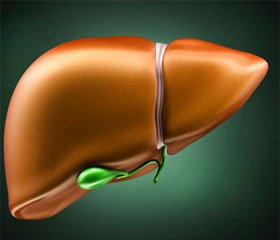The article was published on p. 74-75
Osteoporosis (OP) — one of the most pressing current medical and socio-economic problems of society. OP has a special place among the diseases associated with the violation of a metabolic changes in bone tissue (BT). Bone mineral density (BMD), which is formed up to 20 years, determines the factors of risk of Opand osteoporosis fractures in the elderly. There is a need to create favorable conditions for achieving the respective MDBT in childhood and adolescence, the selection of quality criteria for preclinical diagnosis of OP for early detection of metabolic disorders BT.
Aim of this work was to establish the relationship between MDBT in children with chronic hepatitis B and/or C and body mass index (BMI).
Under the supervision were 37 children with chronic hepatitis B and/or C, which were confirmed by using ELISA and PCR. Children’s age ranged from 5 to 15 years. In 59.5 % of patients with chronic hepatitis (CH) was inactive phase of the process, and in 40.5 % — the minimum activity and in all cases it ran in anicteric forms. The boys among the examined were 23 (62.2 %), girls — 14 (37.8 %). All children conducted densitometry study of the first four lumbar vertebras by the densitometer DPX-A company Lunar corporation by a method of dual energy X-ray absorption in a mode «Children». The results of examination were densytograma, and calculated by a computer program sizes (Age Matched, BMC, BMD, Area). The main parameters that define the BMD, is the content of minerals in the examined bone (BMC, g), and the mineral density of bones (VMD g/cm2), the criterion Age Matched, which is expressed as a percentage of age-ethnic and weight regulation (%) and in terms of the standard deviation of the average theoretical rules (Z). Value index Z, according to WHO, from (–1,0 to –2,5) would regard as the initial development of bone changes or osteopenic syndrome of (–2,5 to –2,0) — osteopenia ІІІ degree, from (–2,0 to –1,5) — osteopenia second degree, and from (–1,5 to –1,0) — osteopenia first degree; value Z to (–1,0) consider normal. In dismissing Z less (–2,5) diagnosed with so-called «set OP».
In addition, studying the interdependence of BMI (the ratio of body weight to growth in square of examenated expressed in kg/m2) and BMD.
Reduced BMD, given the value of Z, was diagnosed in 18 (48.7 %) patients, in particular, the degree of I degree of osteopenia — 2.7 %, II degree — 21.7 %, III degree — 10.8 % and OP — in 13.5 % of patients.
In the study in depth osteopenic syndrome surveyed a direct correlation between the values of BMD (r = 0.75), Z (r = 0.63) and the value of BMI.
Body mass index in patients with low BMD (15.84 ± 0.58) kg/m2 was authentically (p < 0,05) lower than in patients with normal bone mineralization (19.30 ± ± 0.62) kg/m2 and in healthy children (23.42 ± 0.53) kg/m2. It was also found authentically (p < 0,05) reduction in body mass index in patients with osteopenia I + II, III degrees and OP against children of the control group and patients with normal bone mineralization. Differences of this indicator depending on sex and activity of CH is not found, but found significant (p < 0,05) differences in values of body mass index between different age groups with low BMD, (14,21 ± 1,06) kg/m2 — children and 5–10 years (18.54 ± 0.55) kg/m2 — in persons 11–15 years, respectively.
In this way, body mass index with a value (15.84 ± 0.58) kg/m2 and below may be one of the diagnostic criteria osteopenic syndrome in children with inaparant and subclinical forms of chronic hepatitis B and/or C.

